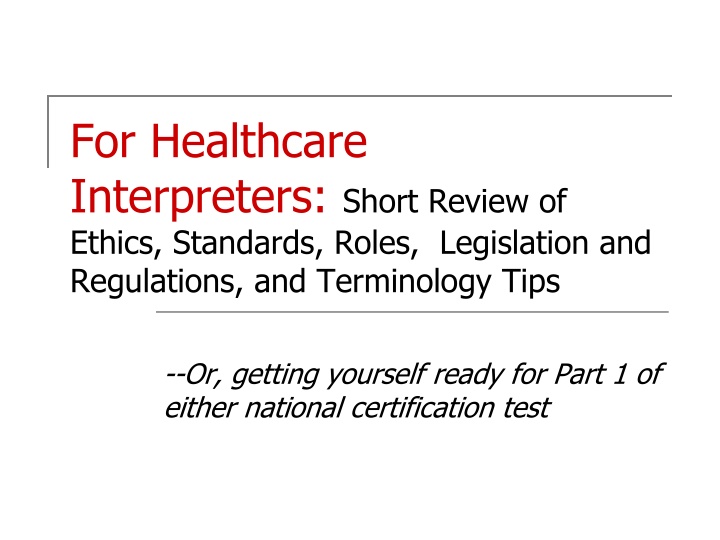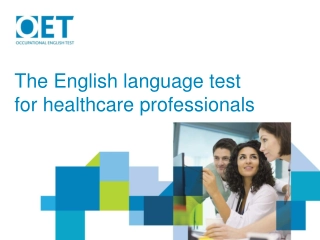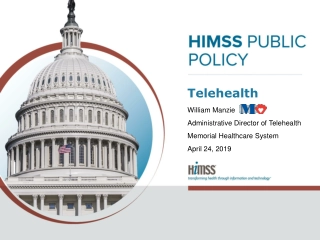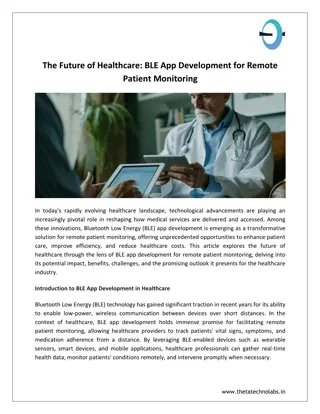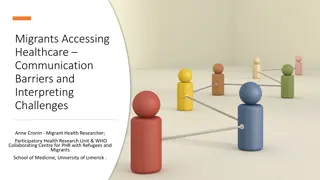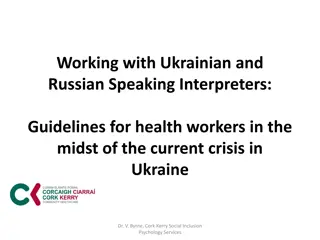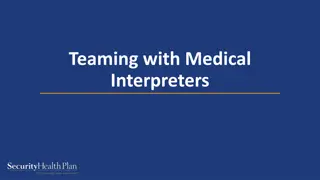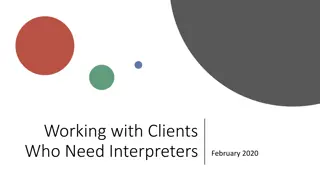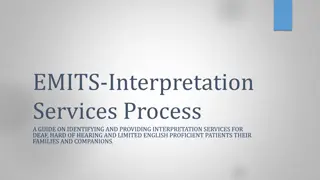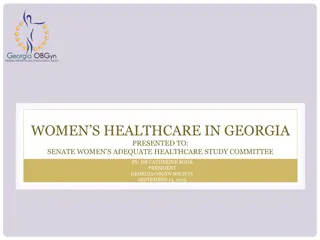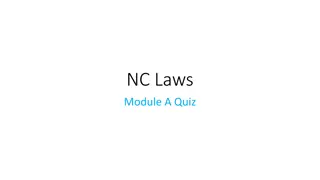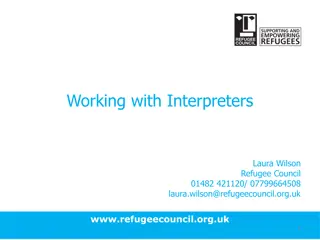Essential Review for Healthcare Interpreters
This review covers ethics, standards, roles, legislation, and terminology tips crucial for healthcare interpreters to prepare for national certification tests. It includes learning objectives and credits valuable resources used in compiling this comprehensive guide.
Download Presentation

Please find below an Image/Link to download the presentation.
The content on the website is provided AS IS for your information and personal use only. It may not be sold, licensed, or shared on other websites without obtaining consent from the author.If you encounter any issues during the download, it is possible that the publisher has removed the file from their server.
You are allowed to download the files provided on this website for personal or commercial use, subject to the condition that they are used lawfully. All files are the property of their respective owners.
The content on the website is provided AS IS for your information and personal use only. It may not be sold, licensed, or shared on other websites without obtaining consent from the author.
E N D
Presentation Transcript
For Healthcare Interpreters: Short Review of Ethics, Standards, Roles, Legislation and Regulations, and Terminology Tips --Or, getting yourself ready for Part 1 of either national certification test
Learning Objectives: Recall concepts from introductory courses in healthcare interpreting that are fundamental such as the purpose of the pre-session, how and when to intervene to support effective communication, and the meaning of the principle of transparency; Define ethics, standards, roles and other terms of art for the interpreting profession; Recognize the laws and regulations that inform language access practices and policies in healthcare; and Identify ways to improve your command of medical terminology. Beverly Treumann for Health Care Interpreter Network 2016 2
Credit where credit is due: For this short class, I followed the lists of topics for both tests, selecting material from a 40-hr course developed at L.A. Care Health Plan (a course I taught more than a dozen times from 2005 to 2008) and the publications of the three nationally recognized organizations that have published ethics and standards for healthcare interpreters: CHIA, IMIA and NCIHC. California Healthcare Interpreting Association www.chiaonline.org International Medical Interpreters Association www.imiaweb.org/ National Council on Interpreting in Health Care www.ncihc.org. I include some slides that I credit to other interpreter trainers. The California Endowment supported the work of many of the organizations and projects that helped to shape the field. Such content is in the public domain. And last, but not least, on several slides, I refer to chapters (specifically Chapters 4 and 10) from Healthcare Interpreting In Small Bites, 50 Nourishing Selections from the Pacific Interpreters Newsletter, by Cynthia E. Roat. To purchase a copy, go to http://cindyroat.com/ Beverly Treumann, CHITM, CMI Beverly Treumann for Health Care Interpreter Network 2016 3
Two organizations offer a nationally recognized certification test: CCHI and NBCMI http://www.cchicertification.org/ http://www.certifiedmedicalinterpreters.org/ Beverly Treumann for Health Care Interpreter Network 2016 4
About the two tests: Both groups did surveys and based their test content on their respective interpreter responses. The text below originated primarily from a comparison chart created by Elsa Boyer. NBCMI Roles of the Medical Interpreter (8%) Medical Interpreter Ethics (15%) Cultural Competence (8%) Medical Terminology in Working Languages (38%) Medical Specialties in Working Languages (23%) Interpreter Standards of Practice (IMIA, CHIA, NCIHC) (5%) Legislation and Regulations (HIPAA, CLAS) (3%) For detail, go to page 8 of http://www.certifiedmedicalinterpreters.or g//sites/default/files/national-board- candidate-handbook.pdf CCHI Manage an Interpreter Encounter 30-35% Healthcare Terminology 22-25% Interact with Other Healthcare Professionals 20-24% Prepare for an Interpreting Encounter 16-20% Demonstrate Cultural Responsiveness 3-6% For detail, go to http://www.cchicertification.org/i mages/pdfs/testoutline.pdf Beverly Treumann for Health Care Interpreter Network 2016 5
Visit both websites Both groups offer materials to help you prepare for testing including handbooks that you can download, webinars (some are past recordings) and newsletters. Beverly Treumann for Health Care Interpreter Network 2016 6
Managing an Interpreting Encounter? 30-35% of CoreCHI / or Part 1 of CCHI Is that part of the Interpreter Role? Yes. At one time, many non-interpreters believed that the interpreter was like a robot. Roles: 8% of Part 1 NBCMI Message in. Message out. Voila! Communication succeeds across a language barrier! Beverly Treumann for Health Care Interpreter Network 2016 7
But providers and patients do not speak consistently in clear, short statements. If people spoke clearly all the time, we would probably have no comedy TV. Aren t most TV comedies about misunderstandings that happen in everyday life? And all in the same language? Why did anyone ever imagine that interpreting in healthcare was just message in, message out? Beverly Treumann for Health Care Interpreter Network 2016 8
Over the past 20 years or so, many concepts that are better than the robot image have been articulated by interpreters themselves. These have been formalized by academics and by interpreter organizations. Incremental model of intervention was first developed by Cynthia Roat. Interpreter roles Beverly Treumann for Health Care Interpreter Network 2016 9
Roles Patient Advocacy like fats and sweets in the old food pyramid: use sparingly. Roles as listed in the CHIA Standards. Other writers and publications*, including Roat, list cultural broker instead of cultural clarifier. Cultural Clarifier Message Clarifier Message Converter (KP & other material: conduit ) Beverly Treumann for Health Care Interpreter Network 2016 10
Roles Presented at a 2003 CHIA conference: The Healthcare Interpreting Ladder PATIENT ADVOCATE FRAME: HEALTHCARE INTERPRETERS: (Professionalization of Healthcare Interpreting) Systemic Barriers go up & down the steps of the ladder, CULTURAL CLARIFIER CHIA move in & out of roles Testing Culture Barriers Language Training sometimes having each foot on a separate step, playing multiple roles simultaneously MESSAGE CLARIFIER CEUs Organizational Policies Register Barriers MESSAGE CONVERTER Job Descriptions Certification Language Barriers (Risky and complicated!) PRE-SESSION 1ST PERSON - POSITIONING ADVANCED TO SUPERIOR BILINGUAL PROFICIENCY 2016 11
Patient Advocacy When the patient s health, well-being, or dignity is at risk, the interpreter may be justified in acting as an advocate. Advocacy is understood as an action taken on behalf of an individual that goes beyond facilitating communication, with the intention of supporting good health outcomes. Advocacy must only be undertaken after careful and thoughtful analysis of the situation and if other less intrusive actions have not resolved the problem. Tip: Read Chapter 10, Interpreter as Advocate, of Healthcare Interpreting in Small Bites, Roat From National Code of Ethics for Interpreters in Health Care. Beverly Treumann for Health Care Interpreter Network 2016 12
To move between roles, we may intervene (interrupt) 1. Message Converter Role We go back and forth in first person. If we don t hear or remember, we might say As the interpreter, may I ask that you repeat. 2. Message Clarifier Quick example: Pink eye, as the interpreter, may I ask, do you mean conjunctivitis? 3. Cultural Clarifier quick example: A mother of a child on dialysis says Mi hijo se est poniendo gordo. The social worker understands one word as a criticism: fat. 4. Patient Advocate Next time, bring your own interpreter... Beverly Treumann for Health Care Interpreter Network 2016 13
When to intervene: Common problems in message converting The speaker speaks too fast or too softly or does not pause for you to interpret. Someone interrupts you and does not let you finish interpreting. Too many people speak at the same time. Beverly Treumann for Health Care Interpreter Network 2016 14
When to intervene: Common problems in message clarifying Register Lack of linguistic equivalence, managed care terms, healthcare occupations Idiomatic phrases When you, the interpreter, don t understand. When you do understand, but you have reasons to think that the listener may not have understood the speaker. You want to check for understanding. When you need to clarify the meaning of a concept that may be understood differently by the patient and the provider. Example:alergia, pie, Beverly Treumann for Health Care Interpreter Network 2016 15
Intervene to cultural clarify You need to clarify a cultural concept that you suspect may have caused confusion or misunderstanding fat sushi yin and yang risk Intervene to advocate for patient Examples: A patient is being denied a service that he or she is entitled to receive. A patient is being given a service that is of a lower quality than what an English-speaker would receive. Beverly Treumann for Health Care Interpreter Network 2016 16
Ways to intervene: Signal that you will stop interpreting (speak or gesture) Or, better, use your words (transparency) Identify your voice as your own. Say it in both languages. Refer to yourself as the interpreter while intervening. Explain to BOTH parties the reasons why you are intervening, so that everyone understands. Beverly Treumann for Health Care Interpreter Network 2016 17
Goal is Get in. Get out! Once you re done intervening, quickly go back to the message converter role (IMIA, conduit role ) on solid ground. These steps help you avoid having a side conversation with one party, while the other party is left out and does not know what is happening. Beverly Treumann for Health Care Interpreter Network 2016 18
Transparency Means Clarity Chapter 4, Transparency Means Clarity, of Healthcare Interpreting in Small Bites, by Cynthia Roat 1) Transparency means an interpreter who is accurate and complete will interpret everything that is said. 2) When there is confusion the interpreter may intervene for misunderstandings, cultural issue, a repeat, or a pause. 3) Being transparent means that if you have a valid reason to talk to one party, tell the other party what you will do. 4) Being transparent means everyone knows what is being said. Beverly Treumann for Health Care Interpreter Network 2016 19
Transparency means boundaries in NCIHC doc. To maintain professional boundaries means that interpreters fulfill only the duties of a health care interpreter while engaged in the performance of that role and do not assume any duties that are outside that role. (Relates to ethic as listed by NCIHC: The interpreter maintains the boundaries of the professional role, refraining from personal involvement. The intent of this principle is twofold: 1) to provide transparency in the service that is being provided, and 2) to avoid potential conflicts of interest.) Beverly Treumann for Health Care Interpreter Network 2016 20
Definition of transparency from National Council on Interpreting in Health Care. The principle that during the encounter the interpreter informs all parties of any action he or she takes, including speaking for him- or herself, outside of direct interpreting. Beverly Treumann for Health Care Interpreter Network 2016 21
As healthcare interpreters began to make new rules, it became necessary to explain our rules to others. My anecdote: no le entiendo a ella para nada. The pre-session (CHIA) a) introduce yourself: name, language and organizational affiliation if needed. b) confidentiality, explain confidentiality to pt. if needed c) inform parties how to have smooth encounter 1. everything will be interpreted, 2. & 3. recommend that parties speak directly and pause frequently 4. explain that you may need to intervene d) ask provider to brief interpreter Is there anything I need to know before we start? Beverly Treumann for Health Care Interpreter Network 2016 22
Ethics can be defined by a profession. Not the same word as morals. NCIHC Code of Ethics The interpreter treats as confidential, within the treating team, all information learned in the performance of their professional duties, while observing relevant requirements regarding disclosure. The interpreter strives to render the message accurately, conveying the content and spirit of the original message, taking into consideration its cultural content. The interpreter strives to maintain impartiality and refrains from counseling, advising or projecting personal biases or beliefs. Beverly Treumann for Health Care Interpreter Network 2016 23
NCIHC Code of Ethics, continued The interpreter maintains the boundaries of the professional role, refraining from personal involvement. The interpreter continuously strives to develop awareness of his / her own and other (including biomedical) cultures encountered in the performance of their professional duties. Beverly Treumann for Health Care Interpreter Network 2016 24
NCIHC Code of Ethics, continued The interpreter treats all parties with respect. When the patient s health, well-being, or dignity is at risk, the interpreter may be justified in acting as an advocate. The interpreter strives to continually further his / her knowledge and skills. The interpreter must at all times act in a professional and ethical manner. Beverly Treumann for Health Care Interpreter Network 2016 25
National Code of Ethics for Interpreters in Health Care The role of interpreter is a tightrope balancing act: A code of ethics is a good guide for the bar carried on such a walk on the tightrope. It offers balance, some security and especially is a comfortable way to face the unknown risks faced on the interpreter s path. Anonymous Respondent to Code of Ethics Survey quoted in a June 2005 ppt presentation on the Internet by Shiva Bidar-Sielaff, MA; Manager of Interpreter Services & Minority Community Relations-University of Wisconsin Hospital & Clinics Board Member, NCIHC. Ethics not the as rules. 2016 26
For more about Ethics, take Ethics for Healthcare Interpreters (about 1 hour) at http://learn.hcin.org/ (earn 1 CE pt) A brief introduction to the ethics of healthcare interpreting, based on prevailing standards set by professional associations in the field. This course is offered thanks to Suzanne Couture, CHI , a student of Instructional Technology Design, who approached us with a proposal. Beverly Treumann for Health Care Interpreter Network 2016 27
What is a Standards of Practice Set of behavioral and professional expectations Definition of conduct and practice Reflection of existing best practices and prevailing consensus in the field The hows where ethics are the shoulds or the abstract principles Beverly Treumann for Health Care Interpreter Network 2016 28
NCIHC Standards of Practice The National Council on Interpreting in Health Care (NCIHC) developed 32 standards to provide guidance on the qualifications and proper role of the interpreter and define what constitutes good practice. They are designed to promote better communication between patients and health professionals who do not share a language and improve the quality of care for these patients. Text from: http://www.commonwealthfund.org/ Beverly Treumann for Health Care Interpreter Network 2016 29
NCIHC Standards provide guidelines on the following nine ethics: Accuracy: To enable other parties to know precisely what each speaker has said. Confidentiality: To honor the private and personal nature of the health care interaction and maintain trust among all parties. Impartiality: To eliminate the effect of interpreter bias or preference. Respect: To acknowledge the inherent dignity of all parties in the interpreted encounter. Cultural Awareness: To facilitate communication across cultural differences. Role Boundaries: To clarify the scope and limits of the interpreting role, in order to avoid conflicts of interest. Professionalism: To uphold the public's trust in the interpreting profession. Professional Development: To attain the highest possible level of competence and service. Advocacy: To prevent harm to parties whom the interpreter serves. Beverly Treumann for Health Care Interpreter Network 2016 30
Medical Interpreting Standards of Practice, IMIA Identifies 3 duties: A. Interpretation (18 standards) B. Cultural Interface (2 standards) C. Ethical Behavior (7 standards) And groups standards of practice around these themes. 1. Guideposts in the development of educational and training programs. 2. Evaluation tool. 3. Preparation of health care providers to work with interpreters. 4. Foundation for a certification examination. Use as: 2016 31
CHIAs publication spelled out protocols in this way: Protocol 1. Pre-Encounter, Pre-Session, or Pre- Interview Protocol 2. During the Encounter, Session, or Interview Protocol 3. Post-Encounter, Post-Session, or Post-Interview (make sure session has ended, debrief if nec.) (Protocol: a set of steps or actions) Beverly Treumann for Health Care Interpreter Network 2016 32
Positioning in CHIA Standards, under protocols, during the session, interpreters Position themselves to maximize and encourage direct communication between patient and provider. Can support the three-way partnership and balance the unequal perception of power in the healthcare setting. Supports the patient and provider relationship by directing the provider and patient to look at each other and to speak to each other when they speak. Source: Katharine Allen Beverly Treumann for Health Care Interpreter Network 2016 33
Positioning choices: triangle Triangle Positioning: Frequently used position in healthcare/social service settings. Allows provider & patient to look at interpreter when they speak. Interpreter becomes the center of the session. Provider & patient misses important non-verbal queues. Provider patient fail to develop primary relationship. For spoken languages via video, this is best arrangement. BT Provider Interpreter Source: Katharine Allen Patient Beverly Treumann for Health Care Interpreter Network 2016 34
Positioning choices: Interpreter next to provider Provider can look and speak directly to the patient. Patient may look at provider or interpreter when speaking. Patient may feel intimidated with the feeling of two against one. Source: Katharine Allen Provider Interpreter For ASL via video, this is best arrangement. BT Patient Beverly Treumann for Health Care Interpreter Network 2016 35
Positioning choices: Interpreter next to patient (This idea came from whisper interpreting model.) Provider can look and speak directly to patient. Patient is more likely to look at the provider when speaking. Patient may feel supported during the visit. Patient more likely to develop primary relationship with provider. Source: Katharine Allen Patient Provider Interpreter NOTE: Interpreter will need to use skills to keep provider and patient looking and speaking to each other. Hand gestures, eye contact and verbal reminders can be used to encourage direct communication between the provider and patient. 2016 36
Determine the Interpreting Mode, Modes, or Ways, of Interpreting the actual skills are tested in Part 2 of both exams but for the written exam review what mode is best for what setting. Consecutive Simultaneous* Sight translation (*mode not included on NBCMI test.) Beverly Treumann for Health Care Interpreter Network 2016 37
Dont worry. There is a high level of consensus about what interpreters should know and do. You do not need to memorize lists of ethics or standards. Beverly Treumann for Health Care Interpreter Network 2016 38
Improve your medical terminology Anatomy vs. Physiology from dictionary.com Anatomy 1. the science dealing with the structure of animals and plants. 2. the structure of an animal or plant, or of any of its parts. 3. dissection of all or part of an animal or plant in order to study its structure. 4. a plant or animal that has been or will be dissected, or a model of such a dissected organism. 5. a skeleton. 6. Informal. the human body. 7. an analysis or minute examination. Physiology 1. the branch of biology dealing with the functions and activities of living organisms and their parts, including all physical and chemical processes. 2. the organic processes or functions in an organism or in any of its parts. NBCMI test: medical terminology 38% CCHI: 22 25% Beverly Treumann for Health Care Interpreter Network 2016 39
Look up the function of organs. (Eng. To Eng.) Example: The gallbladder is a pear-shaped, hollow structure located under the liver and on the right side of the abdomen. Its primary function is to store and concentrate bile, a yellow-brown digestive liquid produced by the liver. The gallbladder is part of the biliary tract. The gallbladder serves as a reservoir for bile that is not immediately used for digestion... The bile helps the digestive process by emulsifying fats and neutralizing acids in partially-digested food. An excess of cholesterol, bilirubin or bile salts can cause gallstones to form. Example related to but not from NBCMI test. Beverly Treumann for Health Care Interpreter Network 2016 40
More? Understanding Medical Words: A Tutorial from the National Library of Medicine Tutorial teaches you about medical words. You'll learn about how to put together parts of medical words. You'll also find quizzes to see what you've learned. (77 slides with audio) http://www.nlm.nih.gov/medlineplus/medic alwords.html Beverly Treumann for Health Care Interpreter Network 2016 41
More? Coursera course Clinical Terminology for International and U.S. Students offered by the University of Pittsburgh. 6 weeks starts two or three times a year 2-4 hours of work / week English, English subtitles If you sign up you will receive emails alerting you to the next start date. The course is free but a person who wants a certificate verifying complete participation needs to pay $49. The course offers a lot of instruction and content for that price. To learn more about it, copy this string into your browser. https://www.coursera.org/course/clinicalterminology Des Moines University also offers a free course in Eng & in Spanish https://www.dmu.edu/medterms/ Certificate for 2.0 hours is $99. Beverly Treumann for Health Care Interpreter Network 2016 42
Legislation and Regulations (3% of NBCMI / and a similar fraction of Interact with other Healthcare Professionals - CCHI) We won t spend much time, so this is the quick list: 1. Civil Rights Act of 1964, Title VI 2. OCR and LEP Guidance 3. CLAS 4. HIPAA 5. Joint Commission Beverly Treumann for Health Care Interpreter Network 2016 43
What are Civil Rights? Answer: Civil rights are personal rights guaranteed and protected by the U.S. Constitution and federal laws enacted by Congress, such as the Civil Rights Act of 1964 and the Americans with Disabilities Act of 1990. Civil rights include, for example, freedom of speech, the right to vote, due process of law, equal protection of the laws, and protection from unlawful discrimination. Beverly Treumann for Health Care Interpreter Network 2016 44
Title VI of the Civil Rights Act of 1964 protects persons from discrimination based on their race, color, or national origin. The 1964 law does not address language specifically. However, the Office for Civil Rights explains much later that the language a person speaks is related to his or her national origin. In its Policy Guidance on the Prohibition Against National Origin Discrimination As it Affects Persons with Limited English Proficiency the OCR explains that national origin discrimination includes practices that result in denying a service or other benefit provided as a part of health or social services. For more information, visit http://www.hhs.gov/sites/default/files/ocr/civilrights/resources/factsheets/yourright sundertitleviofthecivilrightsact.pdf (Title II of this Act outlawed discrimination based on race, color, religion or national origin in hotels, motels, restaurants, theaters, and all other public accommodations engaged in interstate commerce; exempted private clubs without defining the term "private". Title VII prohibits discrimination by covered employers on the basis of race, color, religion, sex or national origin.) Beverly Treumann for Health Care Interpreter Network 2016 45
Culturally and Linguistically Appropriate Standards (CLAS) The 14 standards are organized by themes: Culturally Competent Care (Standards 1-3), Language Access Services (Standards 4-7), and Organizational Supports for Cultural Competence (Standards 8-14). Standards 4 through 7 are based on Title VI and LEP Guidance. The other guidelines are recommended by Office of Minority Health (OMH of US Dept of Health and Human Services) for adoption as mandates. You can find the full list here: http://www.imiaweb.org/resources/clas.asp Beverly Treumann for Health Care Interpreter Network 2016 46
Standard 4 - Health care organizations must offer and provide language assistance services, including bilingual staff and interpreter services, at no cost to each patient/consumer with limited English proficiency at all points of contact, in a timely manner during all hours of operation. Standard 5 - Health care organizations must provide to patients/consumers in their preferred language both verbal offers and written notices informing them of their right to receive language assistance services. Beverly Treumann for Health Care Interpreter Network 2016 47
Standard 6 - Health care organizations must assure the competence of language assistance provided to limited English proficient patients/consumers by interpreters and bilingual staff. Family and friends should not be used to provide interpretation services (except on request by the patient/consumer). Standard 7 - Health care organizations must make available easily understood patient-related materials and post signage in the languages of the commonly encountered groups and/or groups represented in the service area. Beverly Treumann for Health Care Interpreter Network 2016 48
HIPAA HIPAA The Health Insurance Portability and Accountability Act of 1996 was enacted by the United States Congress and signed by President Bill Clinton in 1996. Title I of HIPAA protects health insurance coverage for workers and their families when they change or lose their jobs. Title II of HIPAA defines policies, procedures and guidelines for maintaining the privacy and security of individually identifiable health information as well as outlining numerous offenses relating to health care and sets civil and criminal penalties for violations. Common HIPAA violations, according to HHS (www.hhs.gov), Misuse and disclosures of PHI No protection in place of health information Patient unable to access their health information Using or disclosing more than the minimum necessary protected health information Beverly Treumann for Health Care Interpreter Network 2016 49
Want to know more re HIPAA? UCLA Medical Center has an online training on HIPAA that is accessible to the public HIPAA Privacy and Information Security Training for New Workforce Members. http://hshr.mednet.ucla.edu/s/trainings/policies procedures/publish/ocr.htm Their quiz has 11 questions. Good practice. It's here: https://hshr.mednet.ucla.edu/s/trainings/policies procedures/publish3/quiz.htm Beverly Treumann for Health Care Interpreter Network 2016 50
